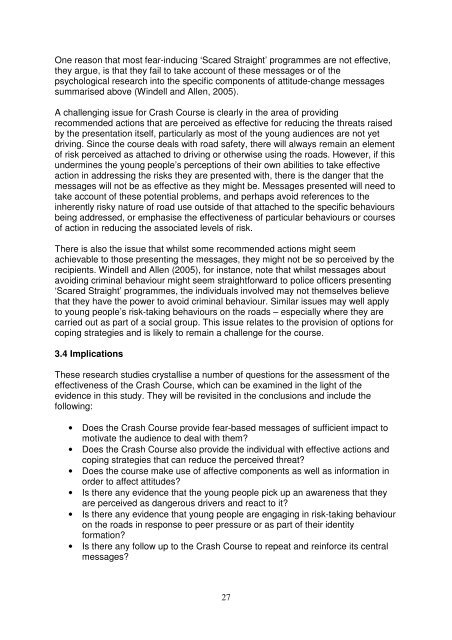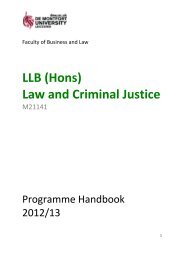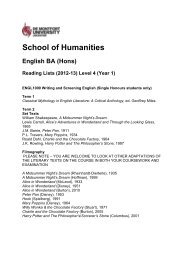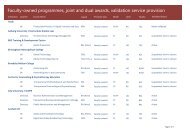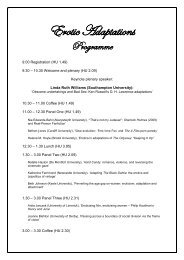Evaluation of the Crash Course March 2009 - De Montfort University
Evaluation of the Crash Course March 2009 - De Montfort University
Evaluation of the Crash Course March 2009 - De Montfort University
You also want an ePaper? Increase the reach of your titles
YUMPU automatically turns print PDFs into web optimized ePapers that Google loves.
One reason that most fear-inducing ‘Scared Straight’ programmes are not effective,<br />
<strong>the</strong>y argue, is that <strong>the</strong>y fail to take account <strong>of</strong> <strong>the</strong>se messages or <strong>of</strong> <strong>the</strong><br />
psychological research into <strong>the</strong> specific components <strong>of</strong> attitude-change messages<br />
summarised above (Windell and Allen, 2005).<br />
A challenging issue for <strong>Crash</strong> <strong>Course</strong> is clearly in <strong>the</strong> area <strong>of</strong> providing<br />
recommended actions that are perceived as effective for reducing <strong>the</strong> threats raised<br />
by <strong>the</strong> presentation itself, particularly as most <strong>of</strong> <strong>the</strong> young audiences are not yet<br />
driving. Since <strong>the</strong> course deals with road safety, <strong>the</strong>re will always remain an element<br />
<strong>of</strong> risk perceived as attached to driving or o<strong>the</strong>rwise using <strong>the</strong> roads. However, if this<br />
undermines <strong>the</strong> young people’s perceptions <strong>of</strong> <strong>the</strong>ir own abilities to take effective<br />
action in addressing <strong>the</strong> risks <strong>the</strong>y are presented with, <strong>the</strong>re is <strong>the</strong> danger that <strong>the</strong><br />
messages will not be as effective as <strong>the</strong>y might be. Messages presented will need to<br />
take account <strong>of</strong> <strong>the</strong>se potential problems, and perhaps avoid references to <strong>the</strong><br />
inherently risky nature <strong>of</strong> road use outside <strong>of</strong> that attached to <strong>the</strong> specific behaviours<br />
being addressed, or emphasise <strong>the</strong> effectiveness <strong>of</strong> particular behaviours or courses<br />
<strong>of</strong> action in reducing <strong>the</strong> associated levels <strong>of</strong> risk.<br />
There is also <strong>the</strong> issue that whilst some recommended actions might seem<br />
achievable to those presenting <strong>the</strong> messages, <strong>the</strong>y might not be so perceived by <strong>the</strong><br />
recipients. Windell and Allen (2005), for instance, note that whilst messages about<br />
avoiding criminal behaviour might seem straightforward to police <strong>of</strong>ficers presenting<br />
‘Scared Straight’ programmes, <strong>the</strong> individuals involved may not <strong>the</strong>mselves believe<br />
that <strong>the</strong>y have <strong>the</strong> power to avoid criminal behaviour. Similar issues may well apply<br />
to young people’s risk-taking behaviours on <strong>the</strong> roads – especially where <strong>the</strong>y are<br />
carried out as part <strong>of</strong> a social group. This issue relates to <strong>the</strong> provision <strong>of</strong> options for<br />
coping strategies and is likely to remain a challenge for <strong>the</strong> course.<br />
3.4 Implications<br />
These research studies crystallise a number <strong>of</strong> questions for <strong>the</strong> assessment <strong>of</strong> <strong>the</strong><br />
effectiveness <strong>of</strong> <strong>the</strong> <strong>Crash</strong> <strong>Course</strong>, which can be examined in <strong>the</strong> light <strong>of</strong> <strong>the</strong><br />
evidence in this study. They will be revisited in <strong>the</strong> conclusions and include <strong>the</strong><br />
following:<br />
• Does <strong>the</strong> <strong>Crash</strong> <strong>Course</strong> provide fear-based messages <strong>of</strong> sufficient impact to<br />
motivate <strong>the</strong> audience to deal with <strong>the</strong>m?<br />
• Does <strong>the</strong> <strong>Crash</strong> <strong>Course</strong> also provide <strong>the</strong> individual with effective actions and<br />
coping strategies that can reduce <strong>the</strong> perceived threat?<br />
• Does <strong>the</strong> course make use <strong>of</strong> affective components as well as information in<br />
order to affect attitudes?<br />
• Is <strong>the</strong>re any evidence that <strong>the</strong> young people pick up an awareness that <strong>the</strong>y<br />
are perceived as dangerous drivers and react to it?<br />
• Is <strong>the</strong>re any evidence that young people are engaging in risk-taking behaviour<br />
on <strong>the</strong> roads in response to peer pressure or as part <strong>of</strong> <strong>the</strong>ir identity<br />
formation?<br />
• Is <strong>the</strong>re any follow up to <strong>the</strong> <strong>Crash</strong> <strong>Course</strong> to repeat and reinforce its central<br />
messages?<br />
27


